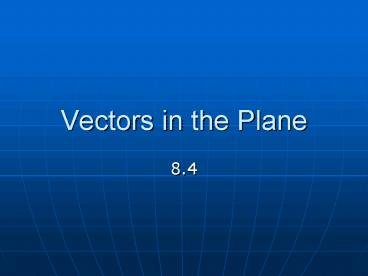Vectors in the Plane - PowerPoint PPT Presentation
1 / 20
Title:
Vectors in the Plane
Description:
Temperature, distance height, area, volume can be ... Parallelogram Law for ... Parallelogram Law for Vector Addition. u. v. u v. Magnitude or ... – PowerPoint PPT presentation
Number of Views:46
Avg rating:3.0/5.0
Title: Vectors in the Plane
1
Vectors in the Plane
- 8.4
2
Scalar
- A single real number that indicates magnitude or
size of a given quantity. Temperature, distance
height, area, volume can be represented by
scalars.
3
Directed Line Segments
- Used to represent a magnitude and a direction or
quantities such as force, velocity, and
acceleration.
4
Directed Line Segments
- Named just like a ray in geometry. The initial
point (P) is listed first, then the terminal
point (Q). PQ
5
Magnitude or Length of Directed Line Segments
- PQ is the symbol for the magnitude. The
distance formula will be used to find this value. - D v(x2-x1)2 (y2-y1)2
6
Equivalent Directed Line Segments
- Two directed line segments with the same length
and direction.
7
Vectors
- The set of all directed line segments equivalent
to the directed line segment PQ is the vector v
PQ.
8
Equal Vectors
- Two vectors are equal if their corresponding
directed line segments are equivalent.
9
Example
- Showing that vectors are equal
- Show that the magnitude of each is equal.
- Show that the slopes of the vectors are equal.
- Note the vectors are not in the same spot, yet
they will be equivalent.
10
Proving Vectors Equal
- R (7,-3), S (4,-5), O (0,0), and P
(-3,-2). Prove that u v where u is the vector
represented by the directed line segment RS and v
is the vector represented by the directed line
segment OP.
11
Component Form of a Vector
- If v is a vector in the plane equal to the vector
with initial point (x1,y1) and terminal point
(x2,y2), then the component form of v is - vlt(x2x1), (y2y1)gtltv1,v2gt
12
Vector Operations
- Vector Addition
- uvltu1,u2gtltv1,v2gt
- ltu1v1,u2v2gt
- Scalar Multiplication
- ku kltu1,u2gt ltku1,ku2gt
13
Parallelogram Law for Vector Addition
- u v can be obtained geometrically by joining
the terminal point of the first vector to the
initial point of the second vector. The directed
line segment that joins the initial point of the
first and the terminal point of the second is
called the sum.
14
Parallelogram Law for Vector Addition
v
u
u v
15
Magnitude or Length of a Vector
- Let vlt(x2x1), (y2y1)gtltv1,v2gt The distance
formula will be used to find this value if given
P and Q where vPQ. - v v(x2-x1)2 (y2-y1)2
- v(v1)2 (v2)2
16
Unit Vector
- A vector with length one that is in the direction
of the original vector. To find the unit vector,
take the vector and divide each of its components
by its magnitude. - u v/v
17
Write the Linear Combination of the standard unit
vectors i and j
- Given a vector v
- V (v cos ?)i (vsin ? )j
- The unit vector in the direction of v is
- U v/v (cos ?)i (sin ? )j
18
Direction Angles
- The angle used to specify the direction of the
vector. - The angle is the one that the vector makes with
the positive x-axis. - Using sohcahtoa, we can determine that
- vcos ? gives the horizontal component and
v sin ? gives the vertical component.
19
Applications
- Velocity is a vector because it has a magnitude
and direction. The magnitude is called the
speed. - BearingAn angle measured from straight north in
the clockwise direction. - The new velocity or force vector will be the sum
of the two given.
20
Applications
- The actual direction of the force or the velocity
can be found by taking the arctan(y/x). You may
have to add 180 to this result depending on the
quadrant that your resultant vector is in.

